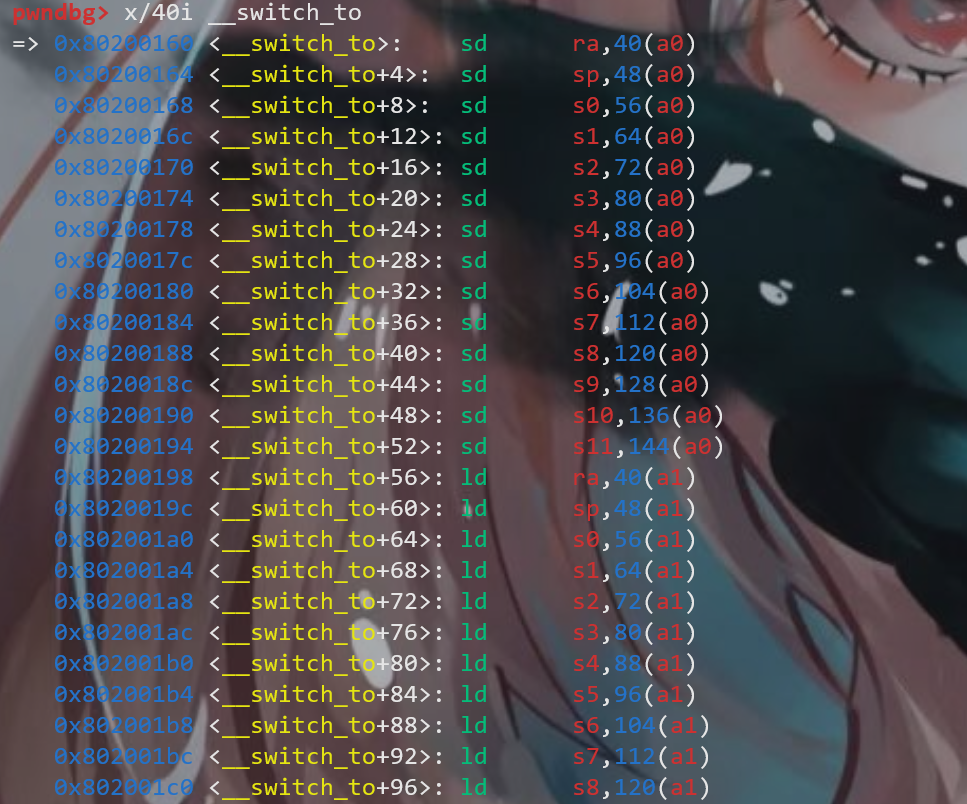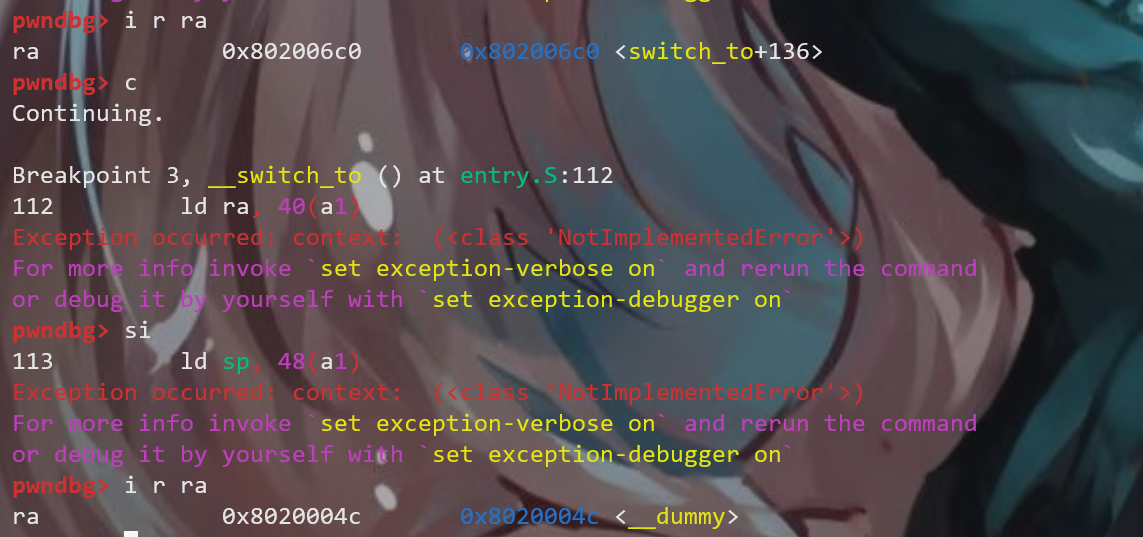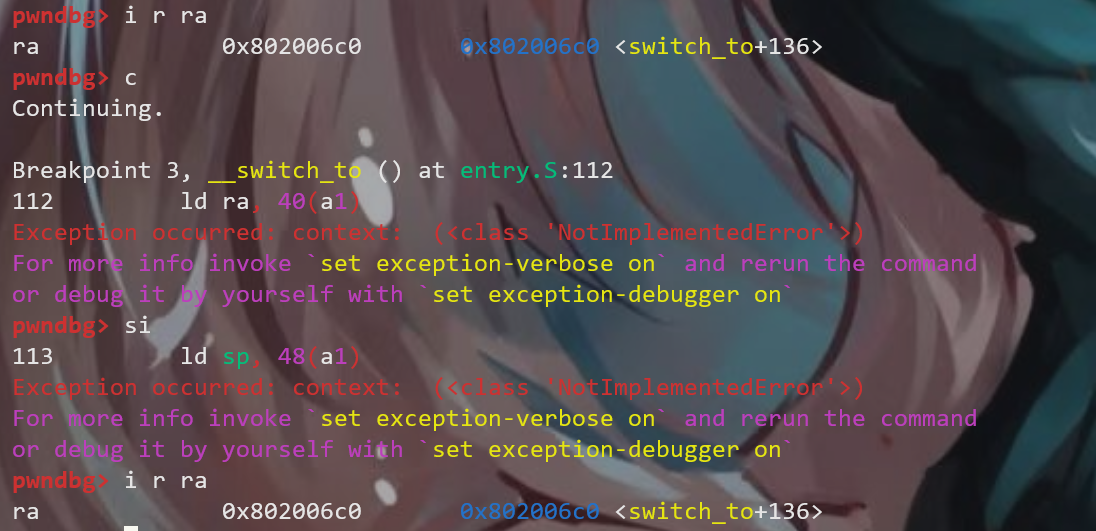引言:
线程是操作系统调度的基本单位,当一个线程的时间片结束之后,操作系统需要选择一个新的线程来占有CPU。本实验需要完成RV64架构下的线程调度机制,探究与线程有关的一些问题。
2 实验步骤
2.1 实验准备
按照实验指导在仓库下添加修改一些文件,包括defs.h,proc.h等
并在proc.c中补全dummy函数和一些函数的定义。
2.2 task_init 线程初始化
按照实验指导并结合已给出的代码逻辑补全
1 2 3 4 5 6 7 8 9 10 11 12 13 14 15 16 17 18 19 20 21 22 23 24 25 26 27 28 29 30 31 32 33 34 35 void task_init () { idle = (struct task_struct*) kalloc(); idle->state = TASK_RUNNING; idle->counter = 0 ; idle->priority = 0 ; idle->pid = 0 ; current = idle; task[0 ] = idle; int i = 0 ; for (i = 1 ;i < NR_TASKS; i++){ struct task_struct * temp =struct task_struct *)kalloc(); temp->state = TASK_RUNNING; temp->counter = 0 ; temp->priority = (uint64)rand()%(PRIORITY_MAX-PRIORITY_MIN+1 )+PRIORITY_MIN; temp->pid = i; (temp->thread).ra = (uint64)__dummy; (temp->thread).sp = (uint64)temp+PGSIZE; task[i] = temp; } printk("...proc_init done!\n" ); }
在设置每个线程的priority时,需要注意数值的范围。因取余后数值是从0开始的,所以我们要加上Priority_MIN使得最后得到的数值是符合要求的。
在C语言中,得到范围在(a,b)中的随机数:
1 result = rand() % (b - a + 1 ) + a;
2.3 switch_to 线程切换
当线程切换时需要保存该线程的上下文到该线程的运行栈上。现在我们需要计算一下具体保存在栈的什么位置。
__swtich_to接受两个参数,一个是当前线程的地址a0,一个是下一个现成的地址a1。 结构体的定义如下。
1 2 3 4 5 6 7 8 9 10 11 12 13 14 15 16 struct thread_struct { uint64 ra; uint64 sp; uint64 s[12 ]; }; struct task_struct { struct thread_info * thread_info ; uint64 state; uint64 counter; uint64 priority; uint64 pid; struct thread_struct thread ; };
其中,thread_info是8bytes的地址值,剩下四个都是8bytes的unsigned int型常量。
所以ra相对于地址值的偏移量为5 * 8 = 40
即我们需要把当前线程的寄存器值保存在a0 + 40的位置,并且从下一个线程的40 + a1处开始恢复寄存器。
1 2 3 4 5 6 7 8 9 10 11 12 13 14 15 16 17 18 19 20 21 22 23 24 25 26 27 28 29 30 31 32 .globl __switch_to __switch_to: sd ra, 40(a0) sd sp, 48(a0) sd s0, 56(a0) sd s1, 64(a0) sd s2, 72(a0) sd s3, 80(a0) sd s4, 88(a0) sd s5, 96(a0) sd s6, 104(a0) sd s7, 112(a0) sd s8, 120(a0) sd s9, 128(a0) sd s10, 136(a0) sd s11, 144(a0) ld ra, 40(a1) ld sp, 48(a1) ld s0, 56(a1) ld s1, 64(a1) ld s2, 72(a1) ld s3, 80(a1) ld s4, 88(a1) ld s5, 96(a1) ld s6, 104(a1) ld s7, 112(a1) ld s8, 120(a1) ld s9, 128(a1) ld s10, 136(a1) ld s11, 144(a1) ret
在切换时,需要对两个线程进行pid值的比较,如果两个线程pid值相等,则不进行切换。
1 2 3 4 5 6 7 8 9 10 extern void __switch_to(struct task_struct* prev, struct task_struct* next);void switch_to (struct task_struct* next) { if (next->pid != current->pid) { printk("\nswitch to [PID = %d PRIORITY = %d COUNTER = %d]\n" , next->pid, next->priority, next->counter); struct task_struct * prev = current = next; __switch_to(prev, next); } }
2.4 do_timer 调度入口
这里需要判断当前线程是否已经运行完毕,是则使用schedule函数进行调度,如果不是继续运行当前线程并执行counter--,直到运行结束。
1 2 3 4 5 6 7 void do_timer () { if (current == idle || current -> counter == 0 ) schedule(); else { current->counter--; if (current->counter == 0 ) schedule(); } }
2.5 schedule 线程调度
在这里我们考虑这几种情况:
当前线程运行完毕,需要切换到下一个进行运行
所有线程均运行完毕,需重新设置
在切换线程时保证先运行counter少的。
根据实验指导中提供的linux执行该算法的源码,编写schedule函数
1 2 3 4 5 6 7 8 9 10 11 12 13 14 15 16 17 18 19 20 21 22 23 24 25 void schedule () { int i , next, c; struct task_struct ** p ; while (1 ){ c = -1 ; next = 0 ; i = NR_TASKS; p = &task[NR_TASKS]; while (--i){ if (!*--p) continue ; if ((*p)->state == TASK_RUNNING && (signed )(*p)->counter > c){ c = (*p)->counter; next = i; } } if (c) break ; for (int j = 1 ; j < NR_TASKS; ++j) { task[j]->counter = task[j]->priority; if (j == 1 ) printk("\n" ); printk("SET [PID = %d PRIORITY = %d COUNTER = %d]\n" , task[j]->pid, task[j]->priority, task[j]->counter); } } switch_to(task[next]); }
需要注意的是,由于我们的counter设置的是unsigned int,如果根据linux的源码执行的话,0 > -1是错误的,因为这时候-1也会被当成是unsigned类型变量。所以我们需要在比较之前加上一个signed指定有符号比较。
linux源码:
1 2 3 4 5 6 7 8 9 10 11 12 13 14 15 16 17 18 while (1 ) { c = -1 ; next = 0 ; i = NR_TASKS; p = &task[NR_TASKS]; while (--i) { if (!*--p) continue ; if ((*p)->state == TASK_RUNNING && (*p)->counter > c) c = (*p)->counter, next = i; } if (c) break ; for (p = &LAST_TASK ; p > &FIRST_TASK ; --p) if (*p) (*p)->counter = ((*p)->counter >> 1 ) + (*p)->priority; } switch_to(next);
2.6 _start段 更改
在最后的跳转之前分别调用mm_init和task_init
如果不对内存初始化,在task_init的时候就会在kalloc这里死掉
1 2 3 4 ......... call mm_init call task_init j start_kernel
3 实验结果
make run运行结果如图:
4 思考题
4.1 在 RV6 4 中一 共用 3 2 个通用寄存器, 为什么 context_switch 中只保 存了 14 个?
在swtich_to中调用__swtich_to时,(由于swtich函数是用C语言写的)会自动把一些寄存保存在栈上,不需要我们手动保存。
所以__switch_to只需要把C语言中没用保存的部分,保存在栈上即可。
4.2 当线程第一次调用时, 其 ra 所代表的返回点是 __dummy。 那么在之后的线程调用中 context_switch 中,ra 保 存 / 恢复的函数返回点是什么呢 ? 请同 学用g db 尝试追踪一次完整的线程切换流程, 并关注每一次 ra 的变换。
追踪完整的线程切换流程,我们现在switch_to处打断点
查看__swtich_to段的地址,并在上下两天sd ra,ld ra处打断点
分别查看ra的值
sd:
ld:
这是第一次,即对线程进行初始化。根据推测出可知前几次都是,所以我们直接c, 每次在这两个断点处查看ra的值
第二次
第三次
第四次
可以看到,从第四次开始,所有线程都已经有了保存的上下文,所以恢复的ra也就都是switch_to+136










